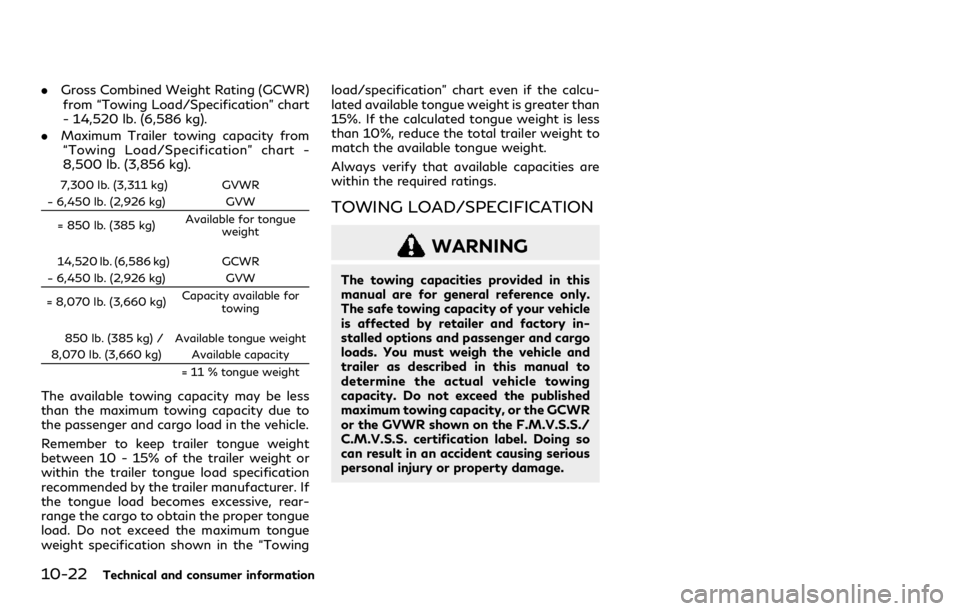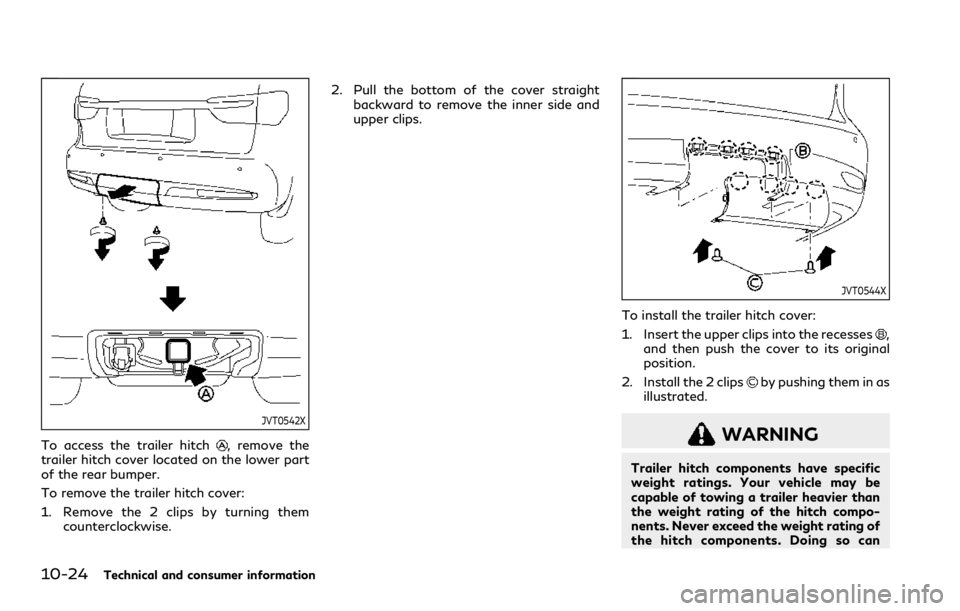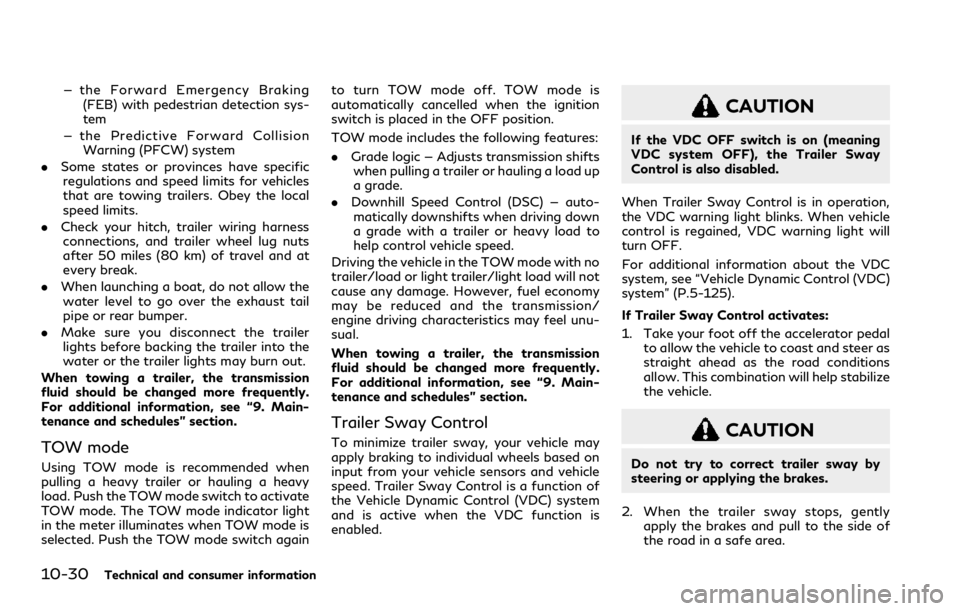warning INFINITI QX80 2021 Owner's Manual
[x] Cancel search | Manufacturer: INFINITI, Model Year: 2021, Model line: QX80, Model: INFINITI QX80 2021Pages: 529, PDF Size: 2.05 MB
Page 500 of 529

ures caused by overloading are
not covered by the vehicle’s
warranty.
MEASUREMENT OF WEIGHTS
Secure loose items to prevent weight
shifts that could affect the balance of
your vehicle. When the vehicle is
loaded, drive to a scale and weigh
the front and the rear wheels sepa-
rately to determine axle loads. Indivi-
dual axle loads should not exceed
either of the gross axle weight ratings
(GAWR). The total of the axle loads
should not exceed the gross vehicle
weight rating (GVWR). These ratings
are given on the vehicle certification
label. If weight ratings are exceeded,
move or remove items to bring all
weights below the ratings.
WARNING
Overloading or improper loading of a
trailer and its cargo can adversely affect
vehicle handling, braking and perfor-
mance and may lead to accidents.
CAUTION
.Do not tow a trailer or haul a heavy
load for the first 500 miles (800 km).
Your engine, axle or other parts could
be damaged.
. For the first 500 miles (800 km) that
you tow a trailer, do not drive over
50 MPH (80 km/h) and do not make
starts at full throttle. This helps the
engine and other parts of your vehicle
wear in at the heavier loads.
Your new vehicle was designed to be used
primarily to carry passengers and cargo.
Remember that towing a trailer places
additional loads on your vehicle’s engine,
drivetrain, steering, braking and other sys-
tems.
An INFINITI Towing Guide (U.S. only) is
available on the website at www.InfinitiUSA.com. This guide includes
information on trailer towing capability and
the special equipment required for proper
towing.
MAXIMUM LOAD LIMITS
Maximum trailer loads
Never allow the total trailer load to exceed
the value specified in the “Towing load/
specification” (P.10-22). The total trailer
load equals trailer weight plus its cargo
weight.
.
When towing a trailer load of 3,500 lbs
(1,587 kg) or more, trailers with a brake
system MUST be used.
The maximum Gross Combined Weight
Rating (GCWR) should not exceed the value
specified in the following “Towing Load/
Specification” chart.
Technical and consumer information10-19
TOWING A TRAILER
Page 501 of 529

10-20Technical and consumer information
STI0541
The GCWR equals the combined weight of
the towing vehicle (including passengers and
cargo) plus the total trailer load. Towing
loads greater than these or using improper
towing equipment could adversely affect
vehicle handling, braking and performance.
The ability of your vehicle to tow a trailer is
not only related to the maximum trailer
loads, but also the places you plan to tow.
Tow weights appropriate for level highway
driving may have to be reduced on very steep
grades or for low traction situations (for
example, on slippery boat ramps).
Temperature conditions can also affect
towing. For example, towing a heavy trailer
in high outside temperatures on gradedroads can affect engine performance and
cause overheating. The transmission high
fluid temperature and engine protection
mode, which helps reduce the chance of
transmission and engine damage, could
activate and automatically decrease engine
power. Vehicle speed may decrease under
high load. Plan your trip carefully to account
for trailer and vehicle load, weather and road
conditions.
WARNING
Overheating can result in reduced engine
power and vehicle speed. The reduced
speed may be lower than other traffic,
which could increase the chance of a
collision. Be especially careful when
driving. If the vehicle cannot maintain a
safe driving speed, pull to the side of the
road in a safe area. Allow the engine to
cool and return to normal operation. See
“If your vehicle overheats” (P.6-14).
CAUTION
Vehicle damage resulting from improper
towing procedures is not covered by
INFINITI warranties.
STI0542
Tongue load
When using a weight carrying or a weight
distributing hitch, keep the tongue load
between 10 to 15% of the total trailer load
or use the trailer tongue load specified by the
trailer manufacturer. The tongue load must
be within the maximum tongue load limits
shown in the following “Towing Load/
Specification” chart. If the tongue load
becomes excessive, rearrange cargo to allow
for proper tongue load.
Page 503 of 529

10-22Technical and consumer information
.Gross Combined Weight Rating (GCWR)
from “Towing Load/Specification” chart
- 14,520 lb. (6,586 kg).
. Maximum Trailer towing capacity from
“Towing Load/Specification” chart -
8,500 lb. (3,856 kg).
7,300 lb. (3,311 kg) GVWR
− 6,450 lb. (2,926 kg) GVW
= 850 lb. (385 kg) Available for tongue
weight
14,520 lb. (6,586 kg) GCWR
− 6,450 lb. (2,926 kg) GVW
= 8,070 lb. (3,660 kg) Capacity available for
towing
850 lb. (385 kg) / Available tongue weight
8,070 lb. (3,660 kg) Available capacity
= 11 % tongue weight
The available towing capacity may be less
than the maximum towing capacity due to
the passenger and cargo load in the vehicle.
Remember to keep trailer tongue weight
between 10 - 15% of the trailer weight or
within the trailer tongue load specification
recommended by the trailer manufacturer. If
the tongue load becomes excessive, rear-
range the cargo to obtain the proper tongue
load. Do not exceed the maximum tongue
weight specification shown in the “Towing load/specification” chart even if the calcu-
lated available tongue weight is greater than
15%. If the calculated tongue weight is less
than 10%, reduce the total trailer weight to
match the available tongue weight.
Always verify that available capacities are
within the required ratings.
TOWING LOAD/SPECIFICATION
WARNING
The towing capacities provided in this
manual are for general reference only.
The safe towing capacity of your vehicle
is affected by retailer and factory in-
stalled options and passenger and cargo
loads. You must weigh the vehicle and
trailer as described in this manual to
determine the actual vehicle towing
capacity. Do not exceed the published
maximum towing capacity, or the GCWR
or the GVWR shown on the F.M.V.S.S./
C.M.V.S.S. certification label. Doing so
can result in an accident causing serious
personal injury or property damage.
Page 505 of 529

10-24Technical and consumer information
JVT0542X
To access the trailer hitch, remove the
trailer hitch cover located on the lower part
of the rear bumper.
To remove the trailer hitch cover:
1. Remove the 2 clips by turning them counterclockwise. 2. Pull the bottom of the cover straight
backward to remove the inner side and
upper clips.
JVT0544X
To install the trailer hitch cover:
1. Insert the upper clips into the recesses
,
and then push the cover to its original
position.
2. Install the 2 clips
by pushing them in as
illustrated.
WARNING
Trailer hitch components have specific
weight ratings. Your vehicle may be
capable of towing a trailer heavier than
the weight rating of the hitch compo-
nents. Never exceed the weight rating of
the hitch components. Doing so can
Page 506 of 529

cause serious personal injury or property
damage.
Hitch ball
Choose a hitch ball of the proper size and
weight rating for your trailer:
.The required hitch ball size is stamped on
most trailer couplers. Most hitch balls
also have the size printed on top of the
ball.
. Choose the proper class hitch ball based
on the trailer weight.
. The diameter of the threaded shank of
the hitch ball must be matched to the ball
mount hole diameter. The hitch ball
shank should be no more than 1/16”
smaller than the hole in the ball mount.
. The threaded shank of the hitch ball must
be long enough to be properly secured to
the ball mount. There should be at least 2
threads showing beyond the lock washer
and nut.
Ball mount
The hitch ball is attached to the ball mount
and the ball mount is inserted into the hitch
receiver. Choose a proper class ball mount
based on the trailer weight. Additionally, the
ball mount should be chosen to keep the
trailer tongue level with the ground.
Weight carrying hitches
A weight carrying or “dead weight” ball
mount is one that is designed to carry the
whole amount of tongue weight and gross
weight directly on the ball mount and on the
receiver.
Weight distribution hitch
This type of hitch is also called a “load-
leveling” or “equalizing” hitch. A set of bars
attach to the ball mount and to the trailer to
distribute the tongue weight (hitch weight)
of your trailer. Many vehicles cannot carry
the full tongue weight of a given trailer, and
need some of the tongue weight transferred
through the frame and pushing down on the
front wheels. This gives stability to the tow
vehicle.
A weight-distributing hitch system (Class IV)
is recommended if you plan to tow trailers
with a maximum weight over 5,000 lbs
(2,267 kg). Check with the trailer and towing
equipment manufacturers to determine if
they recommend the use of a weight-
distributing hitch system.
NOTE:
A weight-distributing hitch system may
affect the operation of trailer surge brakes.
If you are considering use of a weight-
distributing hitch system with a surge brake-equipped trailer, check with the
surge brake, hitch or trailer manufacturer
to determine if and how this can be done.
Follow the instructions provided by the
manufacturer for installing and using the
weight-distributing hitch system.
General set-up instructions are as follows:
1. Park unloaded vehicle on a level surface.
With the ignition switch in the ON
position and the doors closed, allow the
vehicle to stand for several minutes so
that it can level.
2. Measure the height of a reference point on the front and rear bumpers at the
center of the vehicle.
3. Attach the trailer to the vehicle and adjust the hitch equalizers so that the
front bumper height is within 0 - .5
inches (0 - 13 mm) of the reference
height measured in step 2. The rear
bumper should be no higher than the
reference height measured in step 2.
WARNING
Properly adjust the weight distributing
hitch so the rear of the bumper is no
higher than the measured reference
height when the trailer is attached. If
the rear bumper is higher than the
Technical and consumer information10-25
Page 508 of 529

STI0745
Trailer lights
Your vehicle is equipped with a towing
package, which also includes the 7-pin trailer
harness connector located under the trailer
hitch cover on the rear bumper.
CAUTION
.When splicing into the vehicle elec-
trical system, a commercially avail-
able power-type module/converter
must be used to provide power for
all trailer lighting. This unit uses the
vehicle battery as a direct power
source for all trailer lights while using the vehicle tail light, stoplight and
turn signal circuits as a signal source.
The module/converter must draw no
more than 15 milliamps from the stop
and tail lamp circuits. Using a mod-
ule/converter that exceeds these
power requirements may damage
the vehicle’s electrical system. See a
reputable trailer retailer to obtain the
proper equipment and to have it
installed.
. Do not connect electrical devices that
draw more than 40 amps to the
vehicle. The fusible link may melt.
Trailer lights should comply with federal
and/or local regulations. For assistance in
hooking up trailer lights, contact an INFINITI
retailer or reputable trailer retailer.
Trailer brakes
When towing a trailer load of 3,500 lbs.
(1,587 kg) or more, trailers with a brake
system MUST be used. However, most
states require a separate braking system on
trailers with a loaded weight above a
specific amount. Make sure the trailer meets
the local regulations and the regulations
where you plan to tow.
Several types of braking systems are avail-
able. Surge Brakes -
The surge brake actuator is
mounted on the trailer tongue with a
hydraulic line running to each trailer wheel.
Surge brakes are activated by the trailer
pushing against the hitch ball when the tow
vehicle is braking. Hydraulic surge brakes are
common on rental trailers and some boat
trailers. In this type of system, there is no
hydraulic or electric connection for brake
operation between the tow vehicle and the
trailer.
Electric Trailer Brakes - Electric braking
systems are activated by an electronic signal
sent from a trailer brake controller (special
brake sensing module).
Have a professional supplier of towing
equipment make sure the trailer brakes are
properly installed and demonstrate proper
brake function testing.WARNING
Never connect a trailer brake system
directly to the vehicle brake system.
Pre-towing tips
. Be certain your vehicle maintains a level
position when a loaded or unloaded
trailer is hitched. Do not drive the vehicle
if it has an abnormal nose-up or nose-
Technical and consumer information10-27
Page 509 of 529

10-28Technical and consumer information
down condition; check for improper
tongue load, overload, worn suspension
or other possible causes of either condi-
tion.
. Always secure items in the trailer to
prevent load shift while driving.
. Keep the cargo load as low as possible in
the trailer to keep the trailer center of
gravity low.
. Load the trailer so approximately 60% of
the trailer load is in the front half and
40% is in the back half. Also make sure
the load is balanced side to side.
. Check your hitch, trailer tire pressure,
vehicle tire pressure, trailer light opera-
tion, and trailer wheel lug nuts every time
you attach a trailer to the vehicle.
. Be certain your rearview mirrors conform
to all federal, state or local regulations. If
not, install any mirrors required for
towing before driving the vehicle.
. Determine the overall height of the
vehicle and trailer so the required clear-
ance is known.
Trailer towing tips
In order to gain skill and an understanding of
the vehicle’s behavior, you should practice
turning, stopping and backing up in an area
which is free from traffic. Steering stability,
and braking performance will be somewhat different than under normal driving condi-
tions.
.
Always secure items in the trailer to
prevent load shift while driving.
. Lock the trailer hitch coupler with a pin or
lock to prevent the coupler from inad-
vertently becoming unlatched.
. Avoid abrupt starts, acceleration or
stops.
. Avoid sharp turns or lane changes.
. Always drive your vehicle at a moderate
speed. Some states or provinces have
specific speed limits for vehicles that are
towing trailers. Obey the local speed
limits.
. When backing up, hold the bottom of the
steering wheel with one hand. Move
your hand in the direction in which you
want the trailer to go. Make small
corrections and back up slowly. If possi-
ble, have someone guide you when you
are backing up.
Always block the wheels on both vehicle and
trailer when parking. Parking on a slope is
not recommended; however, if you must do
so:
CAUTION
If you move the shift lever to the P
(Park) position before blocking the
wheels and applying the parking brake,
transmission damage could occur.
1. Apply and hold the brake pedal.
2. Have someone place blocks on the downhill side of the vehicle and trailer
wheels.
3. After the wheel blocks are in place, slowly release the brake pedal until the
blocks absorb the vehicle load.
4. Apply the parking brake.
5. Shift the transmission into P (Park).
6. Four-Wheel Drive (4WD) models:
Make sure that the 4WD shift switch is
engaged in the AUTO, 4HI or 4LO
position and the Automatic Transmission
(AT) park warning light is turned off.
7. Turn off the engine.
To drive away:
1. Apply and hold the brake pedal.
2. Start the engine.
3. Shift the transmission into gear.
Page 510 of 529

4. Release the parking brake.
5. Drive slowly until the vehicle and trailerare clear from the blocks.
6. Apply and hold the brake pedal.
7. Have someone retrieve and store the blocks.
. While going downhill, the weight of the
trailer pushing on the tow vehicle may
decrease overall stability. Therefore, to
maintain adequate control, reduce your
speed and shift to a lower gear. Avoid
long or repeated use of the brakes when
descending a hill, as this reduces their
effectiveness and could cause overheat-
ing. Shifting to a lower gear instead
provides “engine braking” and reduces
the need to brake as frequently.
. If the engine coolant temperature rises to
a high temperature, see “If your vehicle
overheats” (P.6-14).
. Trailer towing requires more fuel than
normal circumstances.
. Avoid towing a trailer for your vehicle’s
first 500 miles (800 km).
. Have your vehicle serviced more often
than at intervals specified in the recom-
mended maintenance schedule shown in
the “9. Maintenance and schedules”
section. .
When making a turn, your trailer wheels
will be closer to the inside of the turn
than your vehicle wheels. To compensate
for this, make a larger than normal
turning radius during the turn.
. Crosswinds and rough roads will ad-
versely affect vehicle/trailer handling,
possibly causing vehicle sway. When
being passed by larger vehicles, be pre-
pared for possible changes in crosswinds
that could affect vehicle handling.
Do the following if the trailer begins to sway:
1. Take your foot off the accelerator pedal to allow the vehicle to coast and steer as
straight ahead as the road conditions
allow. This combination will help stabilize
the vehicle.
.Do not correct trailer sway by steering
or applying the brakes.
2. When the trailer sway stops, gently apply the brakes and pull to the side of
the road in a safe area.
3. Try to rearrange the trailer load so it is balanced as described earlier in this
section.
. Be careful when passing other vehicles.
Passing while towing a trailer requires
considerably more distance than normal
passing. Remember the length of the
trailer must also pass the other vehicle
before you can safely change lanes. .
Use the TOW mode or downshift the
transmission to a lower gear for engine
braking when driving down steep or long
hills. This will help slow the vehicle
without applying the brakes.
. Avoid holding the brake pedal down too
long or too frequently. This could cause
the brakes to overheat, resulting in
reduced braking efficiency.
. Increase your following distance to allow
for greater stopping distances while
towing a trailer. Anticipate stops and
brake gradually.
. INFINITI recommends that the cruise
control not be used while towing a
trailer.
. While towing a trailer, do not use the
following systems (if so equipped):
— the Lane Departure Warning (LDW) system
— the Lane Departure Prevention (LDP) system
— the Blind Spot Warning (BSW) system
— the Blind Spot Intervention
®(BSI)
system
— the Back-up Collision Intervention (BCI) system
— the Intelligent Cruise Control (ICC) system
— the Distance Control Assist (DCA) system
Technical and consumer information10-29
Page 511 of 529

10-30Technical and consumer information
— the Forward Emergency Braking(FEB) with pedestrian detection sys-
tem
— the Predictive Forward Collision Warning (PFCW) system
. Some states or provinces have specific
regulations and speed limits for vehicles
that are towing trailers. Obey the local
speed limits.
. Check your hitch, trailer wiring harness
connections, and trailer wheel lug nuts
after 50 miles (80 km) of travel and at
every break.
. When launching a boat, do not allow the
water level to go over the exhaust tail
pipe or rear bumper.
. Make sure you disconnect the trailer
lights before backing the trailer into the
water or the trailer lights may burn out.
When towing a trailer, the transmission
fluid should be changed more frequently.
For additional information, see “9. Main-
tenance and schedules” section.
TOW mode
Using TOW mode is recommended when
pulling a heavy trailer or hauling a heavy
load. Push the TOW mode switch to activate
TOW mode. The TOW mode indicator light
in the meter illuminates when TOW mode is
selected. Push the TOW mode switch again to turn TOW mode off. TOW mode is
automatically cancelled when the ignition
switch is placed in the OFF position.
TOW mode includes the following features:
.
Grade logic — Adjusts transmission shifts
when pulling a trailer or hauling a load up
a grade.
. Downhill Speed Control (DSC) — auto-
matically downshifts when driving down
a grade with a trailer or heavy load to
help control vehicle speed.
Driving the vehicle in the TOW mode with no
trailer/load or light trailer/light load will not
cause any damage. However, fuel economy
may be reduced and the transmission/
engine driving characteristics may feel unu-
sual.
When towing a trailer, the transmission
fluid should be changed more frequently.
For additional information, see “9. Main-
tenance and schedules” section.
Trailer Sway Control
To minimize trailer sway, your vehicle may
apply braking to individual wheels based on
input from your vehicle sensors and vehicle
speed. Trailer Sway Control is a function of
the Vehicle Dynamic Control (VDC) system
and is active when the VDC function is
enabled.
CAUTION
If the VDC OFF switch is on (meaning
VDC system OFF), the Trailer Sway
Control is also disabled.
When Trailer Sway Control is in operation,
the VDC warning light blinks. When vehicle
control is regained, VDC warning light will
turn OFF.
For additional information about the VDC
system, see “Vehicle Dynamic Control (VDC)
system” (P.5-125).
If Trailer Sway Control activates:
1. Take your foot off the accelerator pedal to allow the vehicle to coast and steer as
straight ahead as the road conditions
allow. This combination will help stabilize
the vehicle.
CAUTION
Do not try to correct trailer sway by
steering or applying the brakes.
2. When the trailer sway stops, gently apply the brakes and pull to the side of
the road in a safe area.
Page 513 of 529

10-32Technical and consumer information
TRACTION AA, A, B AND C
The traction grades, from highest to lowest,
are AA, A, B and C. Those grades represent
the tire’s ability to stop on wet pavement as
measured under controlled conditions on
specified government test surfaces of as-
phalt and concrete. A tire marked C may
have poor traction performance.
WARNING
The traction grade assigned to this tire is
based on straight-ahead braking trac-
tion tests, and does not include accel-
eration, cornering, hydroplaning, or peak
traction characteristics.
TEMPERATURE A, B AND C
The temperature grades A (the highest), B,
and C, representing the tire’s resistance to
the generation of heat and its ability to
dissipate heat when tested under controlled
conditions on a specified indoor laboratory
test wheel. Sustained high temperature can
cause the material of the tire to degenerate
and reduce tire life, and excessive tempera-
ture can lead to sudden tire failure. The
grade C corresponds to a level of perfor-
mance which all passenger car tires must
meet under the Federal Motor VehicleSafety Standard No. 109. Grades B and A
represent higher levels of performance on
the laboratory test wheel than the minimum
required by law.
WARNING
The temperature grade for this tire is
established for a tire that is properly
inflated and not overloaded. Excessive
speed, under-inflation, or excessive
loading, either separately or in combina-
tion, can cause heat build-up and possi-
ble tire failure.
Your INFINITI is covered by the following
emission warranties.
For USA:
.
Emission Defects Warranty
. Emissions Performance Warranty
Details of these warranties may be found
with other vehicle warranties in your War-
ranty Information Booklet that comes with
your INFINITI. If you did not receive a
Warranty Information Booklet, or it has
become lost, you may obtain a replacement
by writing to:
. INFINITI Division
Nissan North America, Inc.
Consumer Affairs Department
P.O. Box 685003
Franklin, TN 37068-5003
For Canada:
Emission Control System Warranty
Details of these warranties may be found
with other vehicle warranties in your War-
ranty and Roadside Assistance Information
that comes with your INFINITI. If you did not
receive a Warranty and Roadside Assistance
Information, or it has become lost, you may
obtain a replacement by writing to:
. Nissan Canada Inc.
5290 Orbitor Drive
Mississauga, Ontario,
EMISSION CONTROL SYSTEM
WARRANTY